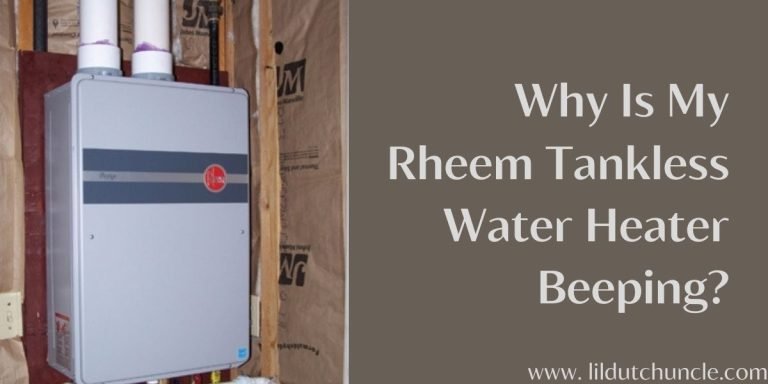
So, what does this F2 code mean? In simple terms, it indicates that there’s an issue with the heater’s temperature sensor or its ability to adequately read and respond to temperature changes. Imagine you’re trying to cook dinner and your stove’s temperature settings are all out of whack. Just as you’d be cautious cooking with an unreliable stove, your water heater is signaling caution because it can’t ensure a consistent water temperature. Let’s dig deeper into why this happens and what you can do about it.
Understanding AO Smith Water Heater Error Code F2
When your AO Smith water heater flashes an Error Code F2, it’s primarily pointing to a problem with the temperature sensor. This sensor acts like the thermostat in your home, constantly monitoring the water’s warmth. If it’s faulty, the system can’t accurately gauge whether the water is too hot or too cold, much like trying to drive a car with a broken speedometer.
Typically, this issue arises from a sensor malfunction or damage, which can happen due to age, electrical issues, or even physical bumps. Just as a bruise might affect your arm’s movement, any physical damage to the sensor can impact its ability to correctly measure temperature. Other times, the sensor might just be dirty or have accumulated mineral deposits, which can impair its performance. Much like smudged glasses affect your vision, a dirty sensor can misread the data, leading to incorrect warnings like the F2 error.
Another possibility is electrical interference or wiring problems. If the wiring that connects the sensor to the heating system is frayed or loose, the sensor might send faulty readings. Picture a jigsaw puzzle with pieces that don’t quite fit; you’ll end up with a skewed picture. Similarly, faulty wiring can prevent the system from getting a complete picture of the water’s temperature.
Common Causes of Error Code F2
Now that we’ve got a basic understanding, let’s explore some of the usual suspects behind the F2 error. An inevitable cause is, as we touched on, the faulty temperature sensor. Over time, like many electronic components, the sensor can wear out. It’s a bit like an old battery that can’t hold a charge anymore. You might also have a situation where the sensor is simply misaligned. If it’s not sitting in the right spot, it won’t read temperature correctly, and this misalignment is akin to trying to measure weight on an unbalanced scale.
Next, consider mineral buildup. Hard water can deposit minerals on the sensor over time, much like how scale forms in a kettle. This buildup can insulate the sensor from the water, preventing it from getting an accurate temperature reading. That’s why routine maintenance and cleaning are crucial to prevent such deposits from causing havoc.
Last but certainly not least, there could be a problem with the dip tube. This piece directs cold water to the bottom of the tank for even heating. If it’s cracked or broken, it might cause false readings, as the water isn’t properly circulating. Think of it as trying to bake a cake with an oven that’s heating unevenly; parts remain raw while others burn.
Steps to Fix Error Code F2
Alright, so your water heater’s crying for help, and you’re itching to fix it. Here’s what you can do: First, start by checking the temperature sensor. Ensure it’s not just a case of it being out of place. Realign it if necessary and double-check for any visible damage or dirt buildup. Cleaning it might resolve the problem, restoring it to its job of accurately reading the water temperature.
If you suspect mineral deposits are the culprits, you’ll need to flush the tank and clean the sensor. Just like descaling a coffee maker, this process helps eliminate those troublesome layers of residue. It’s a good practice to do this periodically, even when things seem to be running smoothly, as it helps prevent errors from cropping up in the first place.
When wiring is the issue, inspect all connections. Here’s where you may need a handy friend or a professional if you’re not comfortable with electrical components. Loose or frayed wires should be corrected or replaced to ensure reliable communication between the sensor and the system.
Preventing Future Issues
Prevention, as they say, is better than cure. Regular maintenance of your water heater can keep the F2 error at bay. Once a year, take the time to inspect and clean the sensors and tank. This proactive approach is like a yearly health check-up, catching potential problems before they become headaches.
It’s also worthwhile to monitor your water’s hardness level and consider installing a water softener if necessary. Softened water reduces the rate of mineral buildup, prolonging the life of your heater’s components. It’s kind of like brushing your teeth to prevent cavities — a simple step that avoids more significant issues down the line.
Lastly, staying vigilant for any unusual sounds or behaviors in your heater is key. Much like a car makes odd noises before a breakdown, your heater will often give subtle warnings before errors like F2 surface. Catch these early, and you’ll save yourself from cold showers and costly repairs.
Those are the steps to understanding and tackling the F2 error code on your AO Smith water heater. With some basic troubleshooting and regular care, you can ensure your showers remain blissfully warm and uninterrupted.